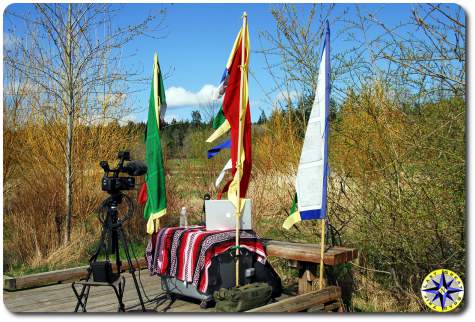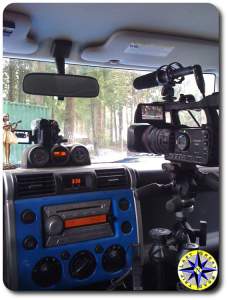 If an off-road adventure happens and nobody records it… did it really? Everyone has a story and we want to tell them is Hula Betty’s motto. That iconic, dashboard bobble doll has been helping tell our stories with off-roading videos going on five years now.
If an off-road adventure happens and nobody records it… did it really? Everyone has a story and we want to tell them is Hula Betty’s motto. That iconic, dashboard bobble doll has been helping tell our stories with off-roading videos going on five years now.
Frequent visitors to our website know we write off-road stories filled with pictures and videos. Recently we received a note from Steve suggesting a little more behind the scenes exposure on how we record it all.
In 2007 when this craziness (my mid-life crisis as Hula Betty refers to it) all started, the only things we had were a slightly modified FJ Cruiser, an Apple laptop and a Nikon. That was was all we needed for our Arctic Circle Adventure. Over the years, we’ve had scores more off-roading adventures and picked up more camera and video gear to record it all. So we thought we would break it all down.
When it comes to photos, we primarily shoot with our Nikon 200D, using an AF-S NIKKOR 24-120mm f/3.5-5.6G IF-ED and AF-S NIKKOR 70-300mm f/4.5-5.6G IF-ED lens. This set up has served us well covering most situations and taking a tremendous amount of abuse on the trail. Dust, bumping around and banging into stuff hasn’t seemed to hurt it.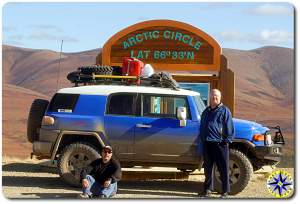
For our Baja adventure we borrowed a Cannon PowerShot G10. It is a very good point-and-shoot camera that fits into a pocket and available at a moment’s notice. We find that the smaller G10 is less intimidating than a full SLR when pointing it at people to capture a smile and you can easily hold it out for the obligatory Facebook self photo. The little PowerShot produces great high-res photos with little or no fuss.
Back in collage I took a photography class and learned the ins and outs of B&W film development. Thankfully, today it is all about digital image editing. The GNU Image Manipulation Program, GIMP for short, is by far the absolute best, amazingly powerful image editing software for the money. As open source software the price is free… but the cost is less than perfect documentation and a somewhat complicated interface. However, once you climb the learning curve and with all the tips and tricks available on the interwebs you can usually find out how to do anything you need. All of our photos go through the GIMP to clean up poor F-stop choices or pull out a little detail as well as adding our logo and border decorations.
The best image editor still wont turn out Pulitzer prize winning photos. Great photos are created in the view finder, composing a shot that expresses emotion and draws you in can not be created in the editor. Our good friend Dan, from Daniel Grayson Images, who is a real bona fide professional with truck loads of lenses, camera bodies, lights and cool studio equipment, has taken amazing images with nothing more than his iPhone. He continues to amaze us with his ability to see and capture a moment regardless of the camera in his hand.
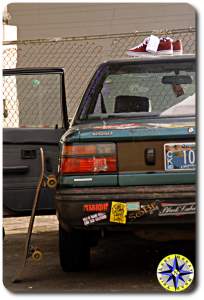 Somewhere in 2008 we took the leap into video. We knew we wanted HD (back in 08 that was new at the consumer level), we also wanted to be able to capture sound in high fidelity to put the full experience of the adventure in the can.
Somewhere in 2008 we took the leap into video. We knew we wanted HD (back in 08 that was new at the consumer level), we also wanted to be able to capture sound in high fidelity to put the full experience of the adventure in the can.
For capturing video our primary camcorder is a Canon XHA1. We ditched the on-board mic for an Audio-technica AT897 shotgun microphone. The XHA1 is a bit bulky and uses now hard to find MiniDV tapes but it has taken all our abuse (we are not easy on stuff) and when it comes to crisp clean video it is hard to beat the three, 1/3″ CCDs. This is the camcorder we primarily use for how-to videos and capturing the big shots on our adventures.
Over time we’ve also added other camcorders in an attempt to get different perspectives. The first one we added was the Bullet DVR 550TVL Pro Series camera which plugs in and uses the Canon to record its images. This little camera gets mounted on the dash or stuck to the side of the rig with a magnet. Since it is rugged and water proof we don’t have much to worry about hanging over the side.
We also picked up a used, palm sized Panasonic PV-GS90P. Nothing special, just aim it and record. It is small and lite which fits the bill for quick grab and go shots, or sticking it out the window while driving down the trail. It has a 42x optical zoom and the ability to off the digital zoom (for better results stay away from digital zoom). Although basic, it produces reasonable quality HD video and provides fill-in shots. This is also a camcorder we can hand off to other drivers or their kids and ask them to record what they want. I’m amazed at the perceptive you’ll get by giving a kid a camera.
Getting video while moving means mounting a camera and keeping it stable over the bumps and ruts. We did a Ram Mount install a while back. With a little ingenuity, we had the Ram Mount holding our tripod’s center column with the XHA1 on top. With a fluid head we were able to adjust the height and get nice pan movement. The setup worked well on pavement but the Canon was too heavy to remain stable off-road. The little Panasonic is lite enough but the Ram Mount just doesn’t remain steady once you raise the center of gravity above the dash.
The newest addition is a little Contour HD 1080P POV recorder. This little camcorder is one of those you mount on your snowboarding helmet or mountain bike and with a little Velcro it can be stuck just about anywhere. It also has a little water proof case when the elements get nasty. The camera uses a CMOS sensor so it does suffer from the “jello” effect when the camera shakes or if panned too quickly, however the wide 135-degree field of view really helps with that jello thing. The sound quality is ok (doubt we’ll use the sound portion) but the video is nice and easy to pull the files off the micro SD card. We’ve just started to play with this POV camera but so far its wide angle and crisp video should provide some nice angles similar to the bullet cam without having to drag the bulk of the XHA1 along.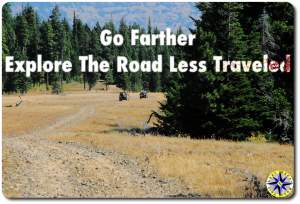
The usual method for creating our videos is to record everything as it happens, hope for the best and then take it into post production to figure out what we have and what we can make out of it. Editing is handled with Final Cut express. It took a while to figure out but was easy enough once we got the hang of it. We just upgraded to Final Cut Pro X which has a completely different interface and is requiring us to change some of the sloppiness in our workflow. But we should be able to more easily synchronize multiple camera angles, adjust contrast, brightness and color as well as hopefully create more dynamic action.
While photography is about composing the shot… video deals in story boards. Telling stories in video is not something we’ve master yet. We understand the concept of story arcs, lighting, sound, movement and angles but we have never been able to put it all together and create the epic tale we’re after. At least not yet.
There is something rewarding about sharing what you enjoy with others. We know our photos are amateur and our videos campy. But I believe it is important to keep your mind engaged and continually work on new things… Hula Betty will tell you I don’t need another hobby. She is probably right. But to be good at anything, it takes 10,000 hours of practice. So if we need to keep going on adventure in order to learn how create real story dimension in our 4×4 videos… Well than that is what we’ll have to do.
We could hurt ourselves… for your entertainment.

